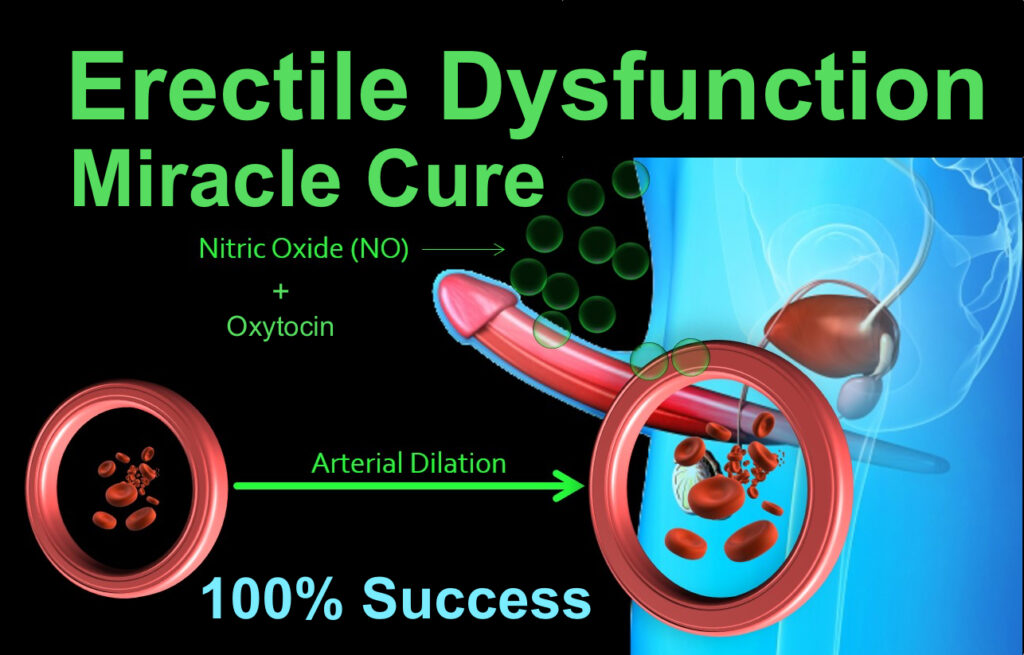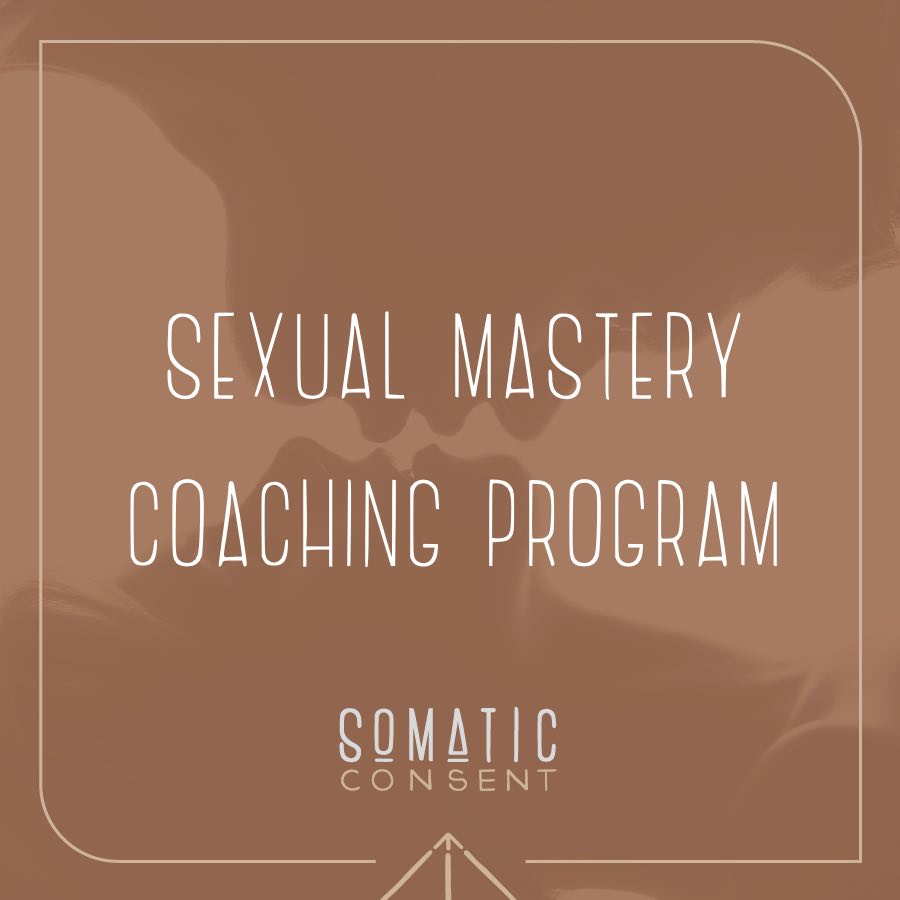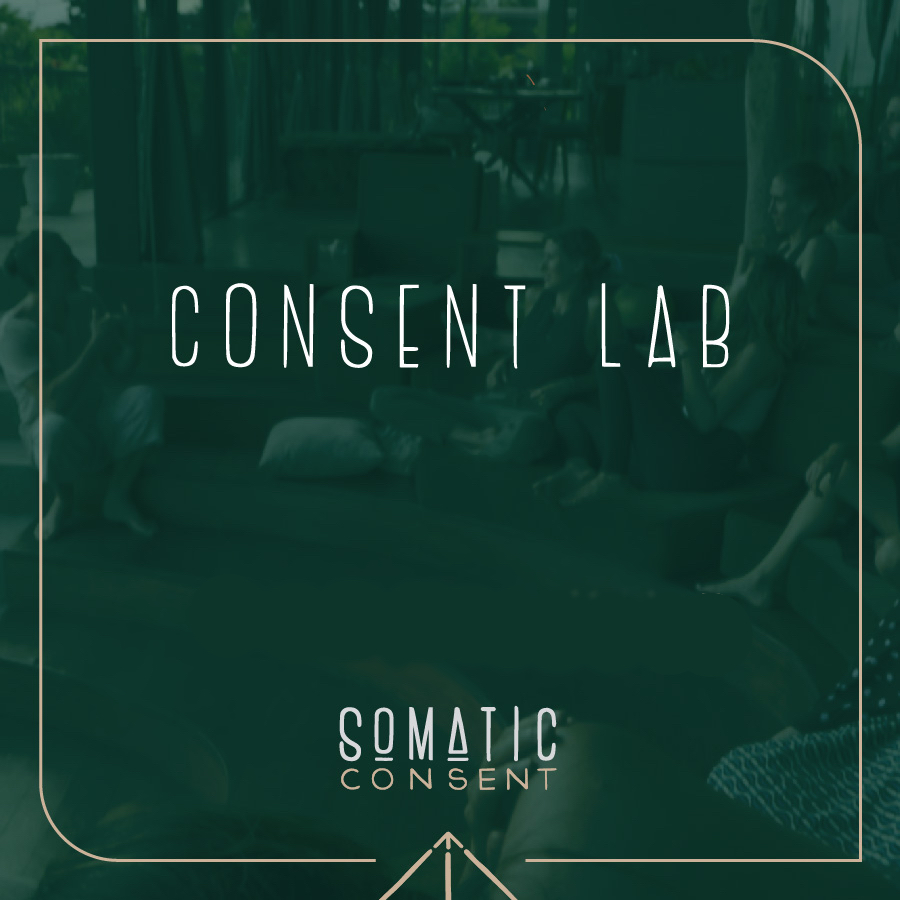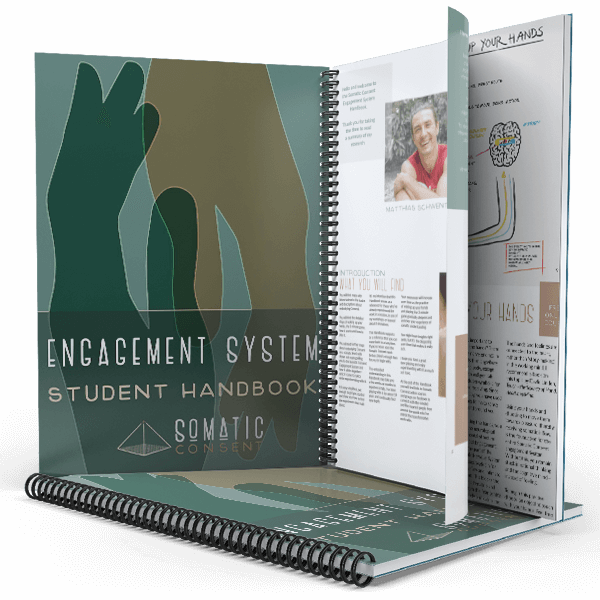
When we transform the dynamics of somatics and consent as a multidimensional map in a pyramid structure, beginning at the base where we integrate shadow dynamics and survival strategies, into self-care and several levels of empowerment we embody through practicing the engagement zones the apex where love and care is offered unconditionally as a gift to and from the world around us, where we merge into spiritual and interpersonal oneness beyond any concepts of duality.

Watch: Somatic Consent Engagement System Map – including the Shadows
Have you heard of this line from a Rumi poem? “You must ask for what you really want, don’t go back to sleep.”
Partly based on this inquiry, Harry Faddis created the 3-minute game, where two people have an equal share receiving what they want.
Asking for what you want is not always easy. So, if you can’t ask for what you want, what are you doing instead to get your needs met?
If there is no permission (to do something for your benefit), the shadow includes bullying, stealing, groping, war, assault and rape.
If there is no agreement (someone agreeing to do something for your benefit), the shadow includes exploitation, freeloading, expectation, laziness, slavery, assumption of privilege and sense of entitlement.
If you can’t express your limits or say no, what are you doing instead?
If there are no limits in giving permission, the shadow shows up in victim behaviour, enduring, tolerating, and being a doormat or a pushover.
If there is no agreement for your action to others, the shadow includes being a pleaser, do-gooder, rescuer, or slave, as well as burn out, guessing, and giving to get.
When you learn to take care of yourself and your limits and when you learn to ask for what you want, you create the base for engagement and connection. Here you understand what you have a right to and responsibility for.
When you stop giving from a place of trying to get something, then giving becomes clean. But in order to give, you need to stop giving for a while to find out how to fully receive.
To embody receiving, you need to fully feel, acknowledge and express what your desire is. Like Rumi implied, you need to know what you want and how to ask for it. If you don’t know how to fully receive, you cannot put aside what you are not aware of, so your giving becomes dependent on getting something.
A fundamental part of the Somatic Consent Engagement System is learning how to ask for permission and create agreements, while clarifying who is doing the action, and if the action is for you or for them.
To ask permission for doing an action for your own benefit, simply make a request. “Can I…?” or “May I…?” Here the other person puts their desires aside.
To create an agreement, you ask someone to do something for you. “Can you…? or “Will you…?” Here you put your desire first and acknowledge the limits of the other person to receive a gift. When you are on the other side and the other person is asking you to do something for them, you put your desires aside and take care of your limits, responding with what you are willing to do.
Or from a more altruistic place, instead of making requests by asking permission or seeking an agreement, you can make an offer without any attachment to the outcome or needing anything in return. This could be in the form of the 3-minute game, as created by Harry Feddis, asking:
“What do you want to do to me?” and “what do you want me to do to you?”
Practicing and embodying the engagement zones, guides you up to the top centre point of the engagement system pyramid – the apex. Here, love and care is given and received from a place of abundance and connection.

Watch: Base Map
The Base Map of the Somatic Consent Engagement System describes what you have a right to and what you are responsible for. This includes, for example, your body, your feelings and emotions, your thoughts, your beliefs and your desires. Self-care here is a priority before you start relating with other people.
The edge of your base is defined by your boundaries – what is ok and what is not ok. Your boundaries and what you have a right to and responsibility for do not change. If you don’t know what you have a right to and responsibility for, then your boundaries can be easily crossed. Sometimes your boundaries need to be crossed in order for you to establish where they are and to learn to respond in a healthy way. This happens when someone reaches out to your base and tells you what to think, believe, feel, or do, or touches you without consent.
Every individual has their own base and what is going on in there is simply their business and no one else’s. When two or more bases engage, each chooses how much they share and how much access they give to the other to their base, as well as any limits they have. This requires an agreement and is the basis for a relationship. The agreement defines what each person wants to share and what each person’s limits are, which can change any time. Both bases contribute to the relationship.
The Somatic Consent Engagement System invites people to create agreements by making clear requests or offers, specifying:
What is going to happen? Where and when? Who is doing the action? Who is it for? And for how long?

Watch: Engagement Zones Map
Somatic Embodiment is about connecting the sensory and motor divisions of the Somatic Nervous System. This is a personal development path that uses pleasure – just let your skin do the work.
It is important to realise that doing an action isn’t always about giving pleasure to another other person. You can be doing an action to receive sensory pleasure yourself. This might be touching a silk fabric because it feels good, or touching a partner for your own pleasure.
So, when you engage with another person, whether it is a friend, lover or colleague, are you doing it for yourself or is it for them?
Or when it’s their action, are they doing it for themself or for you?
This makes a big difference and has a huge impact on intimacy and connection.
When we add consent to these dynamics, we learn how to relate and communicate with others around us about who is ‘doing’ the action and ‘who it’s for’. In Somatic Consent, these dynamics are called the Engagement Zones.
Verbal consent can be divided into permission and agreements.
Permission is asking to do something for your own benefit. “Can I…?” You feel them for your own pleasure.
Or you give someone permission to do something for their benefit. “You can…” You allow them to touch you because it gives them pleasure.
The other type of verbal consent is creating an agreement by requesting an action for your benefit. “Can you…?” For example, they agree to give you a massage in exactly the way you want it.
Or you agree to do something that benefits the other person. “I can…” For example, you agree to do a friend’s shopping.

Watch: Apex Map
To demonstrate the multidimensional nature of personal and spiritual growth, the Somatic Consent Engagement System is depicted as a 3-dimensional pyramid structure with a base and four triangles forming the sides of the pyramid, meeting at the apex.
The transformative journey begins at the base where you integrate shadow dynamics and survival strategies, with an emphasis on self-care and self-responsibility.
The next step is to practice the engagement zones through touch and connection, neurologically embodying consent in the form of permission and agreements. This practice of self-empowerment leads you to the apex of the pyramid. This is the peak of the system where love and care is offered unconditionally as a gift to and from the world, and where you merge into spiritual and transpersonal oneness beyond any concepts of duality.
The internal values of the apex are:
Integrity: alignment of your desires, words and actions; knowing if an action is either for you or for them; learning that you and others have limits.
Gratitude: the joy of feeling grateful for the gifts you receive from either your action or their action.
Surrender: to somebody’s action within your limits, or to your own experience received through a request; inner trustworthiness.
Generosity: providing and sharing from a place of abundance, no attachments to outcome or expectations of anything in return.
At the apex, you become a gift and provide unconditional offerings. You express love and care for yourself, others and the environment. In connection with another person, you find out what both parties want. You explore play, intimacy, connection, relating, mutually beneficial actions, altruism, friendship, empathy, compassion, lovemaking and mindfulness.
From the apex, you can go beyond into the transpersonal space of spiritual development, also known as the bliss state.
The apex is also the doorway back into the engagement zones, the base, and the basement, navigating between the worlds of personal interactions and spiritual development.

Watch: Somatic Consent Engagement System Overview
The Somatic Consent Engagement System is a multidimensional map in a pyramid structure. You begin at the base where you integrate shadow dynamics and survival strategies, then moving into self-care and through several levels of empowerment that are embodied through practicing the engagement zones. At the top of the pyramid, known as the apex, love and care is offered unconditionally as a gift to and from the world around you, and you merge into spiritual and interpersonal oneness beyond any concepts of duality.
The engagement system is actually made up of a number of interrelated maps for personal and spiritual development.
The Polyvagal Theory Map describes the function of the nervous system and how you relate with the world around you. This is determined by either your experience of feeling unsafe, for example, stressed, oppressed or in survival mode; or feeling safe, which is when you can connect and communicate with others, make choices and engage in life in a co-creative way.
The Somatics and Consent Map combines somatic experiencing and consent, and is related to your ability to act and our experience of pleasure.
The Somatic Nervous System is divided into the sensory division which enables you to feel bodily skin-based sensations that are either pleasant or unpleasant, and the motor division which enables you to act by moving towards or away from the stimulus. When you engage with another person, it is verbal consent that creates the safety needed for the Somatic Nervous System to work effectively and for sensations to be experienced fully.
At the base of the Engagement System, you learn that body awareness and capacity for presence and pleasure increase through practising feeling while in moving action. This means that when you touch another person, you stay connected to your own bodily sensations rather than getting lost in the other person’s response. This is known as the direct route of pleasure. Slowing down enough to experience pleasure with both the sensory and motor divisions of the Somatic Nervous System active at the same time, is the foundation of Somatic Consent.
At the base of the Engagement System, as depicted in the Base Map, you realise that you have a right to and responsibility for your body, your feelings, your thoughts, your beliefs and your desires. You are aware of your boundaries and limits and are able to express them when making agreements. You are able to notice what is going on and what feels true in every given moment. You learn to communicate and create consent with the world around you.
The Engagement Zone Map shows how verbal consent can be divided in two ways:
Permission: asking permission to do something for someone “Can I…?” or giving permission for someone to do something for you “Yes, you can…” When permission is given, the person doing the action is doing it for their own benefit.
Agreements: asking someone to do something for you “Can you…?” or agreeing to do something for someone “Yes, I can…” In agreements, the person doing the action is doing it for the benefit of the other person.
These dynamics of verbal consent are known as the engagement zones. To embody the engagement zones, play the 3-minute game a few hundred times with a few hundred people. Or simply ask in any interaction, who is doing the action and who is it for?
When you are in action, it’s either for you, or it is for them.
When they are in action, it’s either for you or for them.
The action is either for your benefit or for their benefit. You can only really know who it is for when you have clearly communicated agreements; that is what makes all the difference in any encounter.
The shadows of the engagement system are when you are unable to ask for what you want, or when you can’t say no and are unable to express your limits and boundaries.
There is a wise saying that you cannot change a system by fighting it; you need to create a new one to make the old one obsolete. You do this by practicing the engagement zones until you fully embody them. Through this embodiment, you reach the top of the pyramid in the Somatic Consent Engagement System, the apex, depicted in the Interpersonal Apex map. Here, human engagement becomes easy and natural, friendship evolves, and love and care is given freely without attachment to the outcome. At the apex, you embody the values of integrity, gratitude, surrender and generosity. Intimate relating becomes a spiritual practice on its own. This guides you into higher states of spiritual awakening beyond the suffering of identifying with personal drama and brings greater compassion and empathy for others on their life journey. You embody divine love and pure presence, moving into a transpersonal state, also known as a bliss state or the void, unified consciousness as meditation of life.

Watch: Noticing and Meaning Map
This map provides some guidance on getting out of your head and into your body. This is useful if you find yourself with looping thoughts in your mind during or after a challenging situation.
The circle in the video represents a head as seen from above. The front side of the brain is the working mind, which creates meaning, story and context, and processes thoughts related to past and future. It is this part of the brain that is activated when you are identified with our thoughts.
In the middle of the brain is the limbic system, where emotions and feelings are processed. This is an evolutionarily older brain structure that developed in the first mammals. Within the limbic system is the amygdala, also known as the fight-flight centre, which controls immediate emotional responses and enables us to detect danger. The amygdala releases cortisol and adrenalin four times a second into the nervous system, enabling us to scan the environment for threats. This is useful, sometimes.
When you get triggered, the working mind recalls a past event and you re-live the unpleasant emotions associated with the memory. The working mind tries to figure out and repair the situation, wanting to get rid of the so-called negative emotions. When the story speeds up and loops around and around, this can cause stress, anxiety and even real panic. As the overwhelm increases, at a certain point the reptilian brain is activated with survival mechanisms such as freezing, shutting down and numbness. The reptilian brain is the oldest of the three brain structures.
When the reptilian brain causes you to shut down, the working mind cannot work it out. This is when the noticing brain can help. The noticing brain is connected to the working brain where you process thoughts, to the limbic brain where you feel your emotions, and to the reptilian brain where you shut down. When you notice what you are experiencing – sensations, emotions and thoughts – you create awareness of ‘what is’. You can do this through mindful practices such as meditation, hugging and body contact, being listened to, and in particular feeling an object with your hands. When you touch an object, you connect with sensory pleasure and oxytocin is released. This blocks the release of cortisol and adrenalin into the blood, enabling the body to calm down, relax, and be in the present moment. The best meditation to stay calm is just to let your skin do the work that the working mind cannot do.

Watch: Map of Mixed Emotions
This graphic shows how the feeling landscape can be divided into four basic feelings: anger, sadness, fear and joy. There can also be mixed feelings. For example, joy and fear mix to create excitement, sadness and anger mix to create depression, joy and anger mix to create malicious joy, sadness and fear mix to create helplessness, sadness and joy create nostalgia and sentimentality, and anger and fear create hysteria.
Expressions of three mixed feelings are aggression, jealousy, greed, guilt, shame, blame and envy. Expressions of four mixed feelings are burnout, collapse and psychological breakdown.
Feelings are for dealing with the here and now, whereas emotions are related to the past and represent an opportunity for healing.

Watch: The Numbness Bar Map
The Numbness Bar Map illustrates how some of us raise the bar, shutting down and suppressing all feelings in order to avoid the healthy expression of desires and limits.
Most people’s numbness bar is high enough to avoid feeling anything most of the time. But when their feelings rise up to the bar and reach a high level of intensity (70-85%), they implode or explode, experiencing anger as rage, sadness as grief, joy as ecstasy and fear as panic. Feelings experienced at 99% intensity would be hell and fear of death. Who knows what might happen at 100%!
To get in connection with yourself and your body, you need to lower the numbness bar, thereby increasing your capacity to experience more subtle feelings, as well as learning how to express these feelings when they show up. To notice subtle feelings needed for emotional intelligence, you need to lower the numbness bar to around 0-10%.
It is important to note that feelings are neutral – neither good nor bad – they are all valuable sources of information and can be used to engage with people and our environment. We want to be able to experience the full range of intensity from 0 to 100%.

Watch: Polyvagal Theory Map
This is a picture of the Triune Autonomic Nervous System.
This system is formed of three levels in a hierarchical structure. It is a down-regulation system, working sequentially from the top to the bottom based on cues of safety or danger.
There are two main functions of this top-down system. One function operates under conditions of stress when you are not feeling safe. The other function is under normal conditions when you feel safe. Safety here is relative – what is safe for one person may be lethal another person, based on individual experiences.
The top level of the Autonomic Nervous System, the Social Engagement System, is recruited first. The Social Engagement System is responsible for controlling breath, heartbeat, facial expression and voice.
The nervous system uses a mechanism called neuroception to process sensory information from the environment and detect danger or threats, and to adapt to the environment. If your neuroception signals a potential threat, the first reaction is to operate within the Social Engagement System and communicate.
If communication fails to bring the body back to a sense of safety, the next level, the Sympathetic Nervous System is activated – the flight response. This is the impulse to get out of the situation by physically leaving or running away. If leaving is not an option, the fight response takes over – the impulse to defend or fight back. The Sympathetic Nervous System enables the full range of movement of the torso and limbs.
If the flight or fight response does not create safety, or if the situation escalates or becomes life-threatening, the Parasympathetic Nervous System is activated and immobilises the body. This shutdown response happens automatically and includes dissociation, fainting and shock.
In other stressful and threatening situations that lie somewhere between social engagement and sympathetic activation, we see protective and defensive behaviours such as negotiation, appeasement, oppression, denial, lying, manipulation, control, and passive aggression.
It is important to note that all of these states are well-functioning survival mechanisms that operate involuntarily to bring you back into a state of safety or to prevent you from feeling pain in the face of death.
Under normal conditions when you feel safe, your nervous system facilitates human connection, for example through face-to-face engagement, eye contact and a soothing or melodic voice. The Sympathetic Nervous System is activated when you engage in activities such as work, sport, dancing, yoga, sex or art. When you feel safe, pleasure and physical connection are possible. This safe mode of sympathetic action is called mobilisation.
When you have exhausted yourself, the body can fall into an immobilised state where you experience rest and rejuvenation. Here you can enter into deep relaxation and ecstatic states through meditation, sexual connection and sleep. In this parasympathetic state, your system can rest in the most exquisite way.
Depending on the situation and environment, the nervous system can change and shift from one state to another in self-regulating and co-regulating or dis-regulating ways, as demonstrated by the arrows in the graphic. This is where different types of therapy and healing methods can help to restore the body-mind connection and create health, rejuvenation, and healthy relationship to self and others.
Last but not least, and where my work focuses, is the safe mode of the nervous system in the area between social engagement and sympathetic mobilisation. This is a hybrid state and the only part of the nervous system where play, sensuality and sexuality are accessible. This is where the Somatic Consent Engagement System fits in, as it is a way to create clear verbal agreements that establish a sense of safety and connection. In particular, Somatic Consent is about physical action with clarity on who is doing the action and who it is for.


Watch: Communication Map
To demonstrate the multidimensional nature of personal and spiritual development, the Somatic Consent Engagement System is represented as a triangle structure evolving into a 3-dimensional matrix of a pyramid.
From the top to the bottom of the triangle, there is the transpersonal space, followed by the interpersonal apex, the engagement zones formed through permission and agreements (by making offers and requests), then the base and the basement.
In the transpersonal state, there are no words, just silence, telepathy, clairvoyance and intuition.
The interpersonal apex is the space for: love and care, being a gift to the world around, offering support, no attachment, no agenda, altruism, empathy and compassion, empowerment, co-creation, mutual benefit, play and conscious communication, intimate connection, a sense of safety, friendship, relating, lovemaking, listening to hear, authentic responding, nonverbal consent, body language, inviting (“I would like… what would you like…?”) and the high drama triangle.
Here we make the crucial distinction between the descending and ascending dynamics of personal and spiritual development; either not being able to rise to higher states of awakening or being afraid of the shadow dynamics of unconscious behaviour in ourself and others.
I am personally interested in exploring all of the shadow dynamics, integrating them and transforming them into love and spirit, discovering deeper layers of being a human and evolving further.
In the basement, we find the dynamics of the low drama triangle: survival strategies, oppression, domination, manipulation, making demands, dictating, commanding, giving orders, making hints, should and shouldn’t, not being able to say no, not being able to ask for what you want, stories, trauma, being reactive, being defensive or protective, having a sense of privilege and expectations (“you should…”, “I must…”), projections (“you are…”, “you can’t”), beliefs (“thou shall not…”, “it is…”, “I am…”), interpretations (“we have to…”, “we can not…”), assumptions (“I am…”, “I have to…”, “they will…”), conclusions (“there isn’t…”, “I am not…”, “they must…”), statements “I want…”), orders or demands (“you have to…”, “do this…”).
Embodiment of the base is an important area of personal development work that includes: self-care, learning what you have a right to and responsibility for, your autonomy and agency, identifying and communicating limits and boundaries, saying and hearing no, identifying and communicating what you are willing to do, learning the difference between permission and agreements and the difference between making an offer and a request, expressing and asking for what you want, noticing, trust, value, and realising that it’s good to acknowledge and express desire without the desperate need for getting what you want.
Once you have done this work at the base, then you are ready for the engagement zones. Here you learn to make clear requests:
“Can I…? Can you…? May I…? Is it ok if I…?”
“Could you…? Will you…? Am I allowed to…? Would you…?”
You also learn to make offers with no attachment to the outcome:
“What would you like me to do for you?”
“What would you like?”
“How do you want me to touch you?”
“What would you like to do to me? Is there anything you need?”
If the engagement zones are embodied then you will be able to differentiate between interpersonal engagement in the apex as love and care, or agenda-related shadow behaviour.

Watch: Relationship Map
The Somatic Consent Engagement System illustrates four types of relationship agreements that have been tried and tested in many relationships over the last five years.
To demonstrate the multidimensional nature of personal and spiritual growth, the Somatic Consent Engagement System is illustrated as a pyramid structure, with the interpersonal apex as the peak of the pyramid, the engagement zones as the four sides (formed of permission and agreements through making offers and requests), the base of the pyramid and below the shadows in the basement.
Starting from the top in a descending dynamic, the interpersonal state of the apex is where you provide love and care for others and the world. This is the first relationship agreement, where you give yourself as a gift: “When I give you a gift, I give freely and you choose what you do with it. If I have attachments and feelings, I will take care of them.”
Moving down the pyramid, at the level of the engagement zones, the second relationship agreement is when you create agreements based on offers and requests:
“If I want you to do something for me i will ask. If I don’t ask, I don’t want anything.”
“You can ask for anything you want and I will take care of my limits. I expect you to do the same in return.”
The third relationship agreement is about being given permission or giving permission based on offers and requests:
“You can feel me and touch me when and how you want to give yourself pleasure. I will take care of my limits. I expect you to do the same in return.
The fourth relationship agreement, at the base of the pyramid, is a commitment to self-care and self-love. Here you are aware of and able to express your limits, boundaries and desires:
“I am responsible for my feelings, limits, and boundaries. You are responsible for your feelings, limits, and boundaries. We are committed to staying open.”
The entire structure of the Somatic Consent Engagement System also works in reverse, ascending from the basement to the base by integrating your shadows, into the engagement zones, up to the interpersonal apex of love and care, and finally moving into the transpersonal space of oneness beyond dualistic relating.























